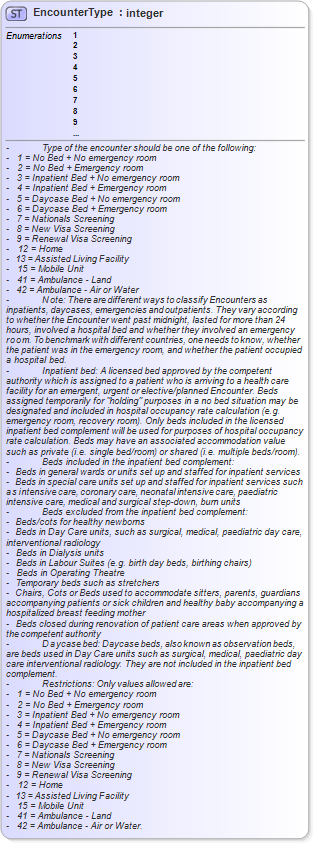<xs:simpleType name="EncounterType">
<xs:annotation>
<xs:documentation>
- Type of the encounter should be one of the following:
- 1 = No Bed + No emergency room
- 2 = No Bed + Emergency room
- 3 = Inpatient Bed + No emergency room
- 4 = Inpatient Bed + Emergency room
- 5 = Daycase Bed + No emergency room
- 6 = Daycase Bed + Emergency room
- 7 = Nationals Screening
- 8 = New Visa Screening
- 9 = Renewal Visa Screening
- 12 = Home
- 13 = Assisted Living Facility
- 15 = Mobile Unit
- 41 = Ambulance - Land
- 42 = Ambulance - Air or Water
- Note: There are different ways to classify Encounters as inpatients, daycases, emergencies and outpatients. They vary according to whether the Encounter went past midnight, lasted for more than 24 hours, involved a hospital bed and whether they involved an emergency room. To benchmark with different countries, one needs to know, whether the patient was in the emergency room, and whether the patient occupied a hospital bed.
- Inpatient bed: A licensed bed approved by the competent authority which is assigned to a patient who is arriving to a health care facility for an emergent, urgent or elective/planned Encounter. Beds assigned temporarily for "holding" purposes in a no bed situation may be designated and included in hospital occupancy rate calculation (e.g. emergency room, recovery room). Only beds included in the licensed inpatient bed complement will be used for purposes of hospital occupancy rate calculation. Beds may have an associated accommodation value such as private (i.e. single bed/room) or shared (i.e. multiple beds/room).
- Beds included in the inpatient bed complement:
- Beds in general wards or units set up and staffed for inpatient services
- Beds in special care units set up and staffed for inpatient services such as intensive care, coronary care, neonatal intensive care, paediatric intensive care, medical and surgical step-down, burn units
- Beds excluded from the inpatient bed complement:
- Beds/cots for healthy newborns
- Beds in Day Care units, such as surgical, medical, paediatric day care, interventional radiology
- Beds in Dialysis units
- Beds in Labour Suites (e.g. birth day beds, birthing chairs)
- Beds in Operating Theatre
- Temporary beds such as stretchers
- Chairs, Cots or Beds used to accommodate sitters, parents, guardians accompanying patients or sick children and healthy baby accompanying a hospitalized breast feeding mother
- Beds closed during renovation of patient care areas when approved by the competent authority
- Daycase bed: Daycase beds, also known as observation beds, are beds used in Day Care units such as surgical, medical, paediatric day care interventional radiology. They are not included in the inpatient bed complement.
- Restrictions: Only values allowed are:
- 1 = No Bed + No emergency room
- 2 = No Bed + Emergency room
- 3 = Inpatient Bed + No emergency room
- 4 = Inpatient Bed + Emergency room
- 5 = Daycase Bed + No emergency room
- 6 = Daycase Bed + Emergency room
- 7 = Nationals Screening
- 8 = New Visa Screening
- 9 = Renewal Visa Screening
- 12 = Home
- 13 = Assisted Living Facility
- 15 = Mobile Unit
- 41 = Ambulance - Land
- 42 = Ambulance - Air or Water.
</xs:documentation>
</xs:annotation>
<xs:restriction base="xs:integer">
<xs:enumeration value="1" />
<xs:enumeration value="2" />
<xs:enumeration value="3" />
<xs:enumeration value="4" />
<xs:enumeration value="5" />
<xs:enumeration value="6" />
<xs:enumeration value="7" />
<xs:enumeration value="8" />
<xs:enumeration value="9" />
<xs:enumeration value="12" />
<xs:enumeration value="13" />
<xs:enumeration value="15" />
<xs:enumeration value="41" />
<xs:enumeration value="42" />
</xs:restriction>
</xs:simpleType>
|

